Blog
BPMN, what's it to us?
(Part 3 of 3)
BPMN (Business Process Model and Notation) is "the new black” at Multi Support. In this third and final in a series of posts I’ll share with you how some of our clients have already embraced BPMN.
In my first two posts you learned that BPMN is much more than a smart way of drawing pretty process diagrams, and that the adaption of BPMN brought along not only a wealth of opportunities but also challenges to Multi Support.
Getting your feet wet
One of the first places we deployed our Next business process engine was at a Norwegian insurance company, migrating from a legacy insurance application to a brand new solution running on Windows. Initially they didn’t appreciate a whole lot the fact that their new workflow was BPMN 2.0 compliant. Focus was on our ability to migrate their users without disrupting their current routines. Next Casework was intended to be the rock solid anchor point in an otherwise turbulent and challenging swap of systems.
Now that they see that one-to-one migration is “a piece of cake”, they are motivated to explore new possibilities once everything else is up and running. Ready to get their feet wet.
Going all the way
At one of our larger industrial clients they have decided to go all the way with BPMN. As most companies they find them selves dealing with a disperse IT landscape consisting of Finance, CRM, MRP, warehouse, and logistics systems - besides the Office package, intranet, and a web site – plus a few other solutions.
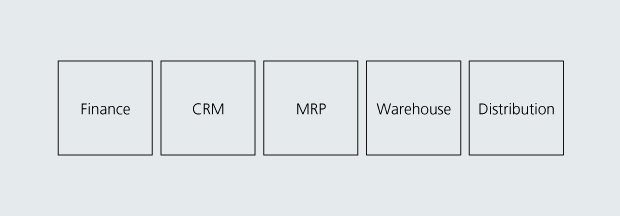
A typical disperse IT landscape.
Not exactly a simple setup, but a professionally and efficiently run IT landscape.
Enterprise document repository
As a long-term Next user they have over the years implemented Next as the shared document repository.
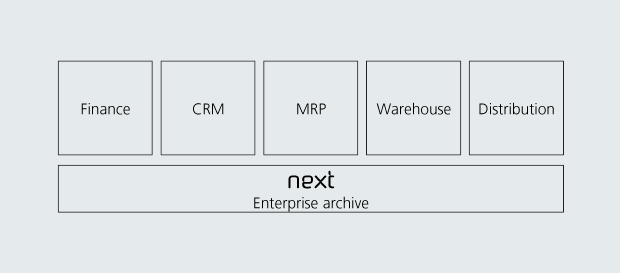
IT landscape with a shared document repository.
All systems store their documents in the Enterprise document repository. No document is left isolated inside the application generating it. This allows all documents to be available to anyone from within all systems. And also makes life much easier the day you want to swap one or more elements in the landscape.
Smart process applications
Again in line with many of our other clients, they have added specific smart process applications to deal with selected business needs.
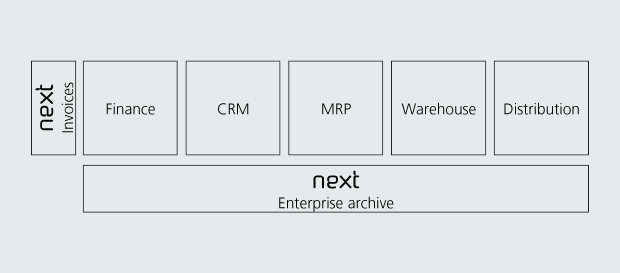
Adding specific smart process applications e.g. Next Invoices.
For example Next Invoices to process and approve supplier invoices totally integrated with the Finance solution.
The extra mile
Where these guys and girls have gone the extra mile is in the decision to map all business processes using BPMN 2.0. Adding a new account to the authorized account plan is a business process. Adding a new payment term is a business process. Adding a new stocked item is a business process. Having all such processes mapped and documented is of immense value for new and existing employees. And for the company as a whole, when you want to be agile and able to change rapidly.
Not only have they decided to map and document their business processes, but also automate the important and complex ones.
Creating a new stocked item in a company is not a simple process; it involves many people, many systems, and takes a long time. At the same time consequences of errors during the actual process are expensive.
When the “Item Coordinator” initiates the “Create Stocked Item” process they decide which departments (Sales, Purchase, Production, Marketing, ..) will be involved in the process, depending on the type of item. At this point the process definition split into different parallel tasks, and users depending on their role in the departments, will be asked to complete their part of the item information. When all departments have confirmed this step, the process is joined again. The item coordinator will check the resulting data before the various business systems are updated automatically using web services.
Next Business process integration
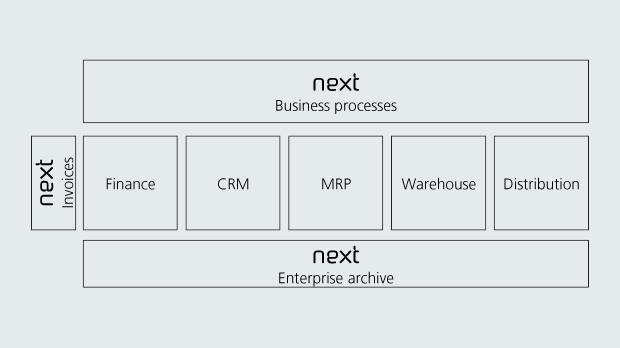
A complete document and process management infrastructure
Adding Next Business processes to the landscape allows them to automate business processes across IT applications and manual routines, in a whole new way. Indeed a very ambitious project. Taking it all the way.
The benefits they stand to harvest are multiple. The entire business process analysis brings along a lot of suggestions for immediate optimization, and leaves behind a company with well-documented processes, much easier to optimize at a later point in time.
SAP future
I have no way of knowing if it’s in their plans to migrate into a SAP environment. But it has been seen to happen before. With an IT landscape based on not only an enterprise document repository, but also a shared business process platform, you are in very good shape to migrate either partially or completely to e.g. SAP.
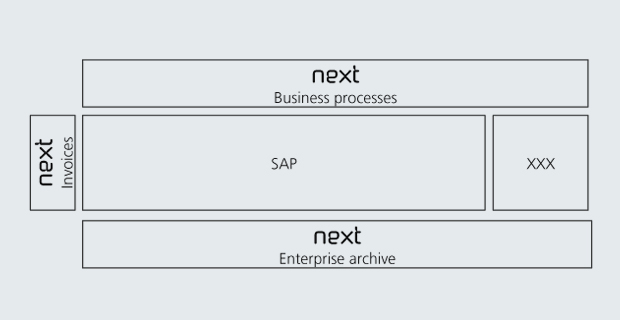
A complete document and process management infrastructure with SAP
Should the future bring a complete wall-to-wall SAP environment, you will see SAP take over some of the processes from Next, while most remain. And remember even the cleanest SAP setup involves a non-SAP component or two
Anywhere in-between
Most of our clients will – I think – be somewhere in-between. Probably starting off carefully, by involving selected super-users in the business process design. I already know of clients who are looking at establishing their own BPMN Center of competence, because the see the potential of this new language shared between real life business people, process analysts, and IT specialists. Getting business processes mapped and visualized. Getting them simulated and optimized.
Got it all wrong?
If you believe that the biggest benefit you stand to gain from the Next process engine is the ability to change your invoice approval workflow with a mouse or a track pad – I think you are wrong. Very wrong.
First of all – real properly defined workflows don’t need changing all the time. They automatically reflect the changes in your organization. Only when you want to change the actual business process you change the definition.
Secondly – you don’t want just anyone sitting around with a mouse or a track pad to manipulate the live definitions governing the daily work of hundreds.
If that is all you are looking for, just go for any of the numerous tools in the marketplace offering a graphical designer. There are plenty to choose from. They will IMHO lead you nowhere.
Getting it right
If, on the other hand, you are interested in taking on a new way of thinking business process management, reengineering, and optimization. Then you have come to the right place. Welcome.
Wrapping up
This was the final post in a short series of blog posts where I have tried to convey to you how important I believe BPMN is. Now and in the near future. Important not only to us at Multi Support, but definitely also to our clients.
While this was very the last post in this series, it’s definitely not going to be the last post on BPMN in this blog.
Gone crazy?
What about a post "Next on Google Glass" showcasing how Next runs on this controversial wearable device?
![]()
Google GlassTM - another device for Next
"But is that BPMN?"
- you bet it is!









